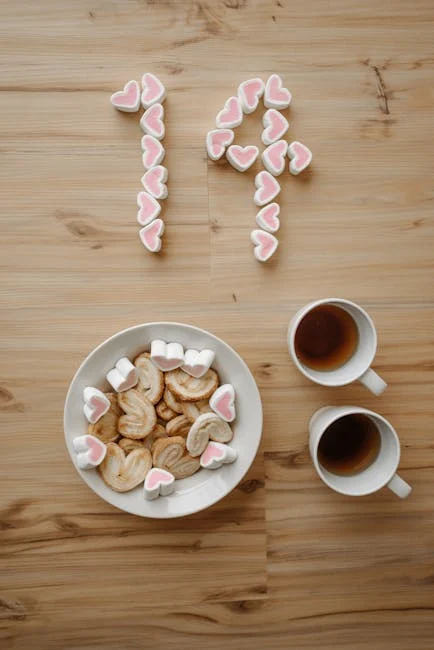Introduction
Baking, a delightful blend of art and science, can sometimes feel daunting. Achieving perfectly baked goods requires more than just following a recipe; it demands understanding key principles and techniques. Whether you’re a seasoned baker or just starting out, these 10 essential tips will elevate your baking game and guarantee delectable results every time.
Main Sections
1. Accurate Measurements: The Foundation of Baking Success
Baking is a precise process, and accurate measurements are paramount. Ditch the guesswork and embrace these practices:
- Use a kitchen scale: Weighing ingredients, especially flour, is far more accurate than using measuring cups.
- Level off dry ingredients: When using measuring cups, gently spoon the ingredient into the cup and level it off with a straight edge.
- Liquid measurements: Use liquid measuring cups and check the level at eye level.
2. Room Temperature Matters: Temperature’s Role in Emulsification
Many recipes call for room temperature ingredients, particularly butter and eggs. Here’s why:
- Butter: Room temperature butter creams more easily with sugar, creating air pockets crucial for light and fluffy baked goods.
- Eggs: Room temperature eggs emulsify better with other ingredients, resulting in a smoother batter and a more even texture.
3. Preheat Your Oven: Ensuring Consistent Baking
Preheating your oven is non-negotiable for even baking. A cold oven can lead to unevenly cooked, dense, or undercooked treats.
- Wait for the signal: Don’t put your baked goods in until the oven reaches the specified temperature.
- Oven thermometer: Use an oven thermometer to verify your oven’s accuracy. Many ovens run hotter or colder than indicated.
4. Don’t Overmix: Preventing Tough Baked Goods
Overmixing develops gluten, which can result in tough, chewy baked goods, especially in cakes and muffins. Here’s how to avoid it:
- Mix until just combined: Stop mixing as soon as the ingredients are incorporated.
- Use a spatula: For the final mixing, use a spatula to gently fold in ingredients, avoiding overmixing.
5. Properly Grease and Flour Your Pans: Ensuring Easy Release
Nothing is more frustrating than a cake that sticks to the pan. Proper preparation is key:
- Grease the pan thoroughly with butter, shortening, or cooking spray.
- Flour the pan, tapping out any excess. For chocolate cakes, use cocoa powder instead of flour.
- Consider using parchment paper to line the bottom of the pan for extra insurance.
6. Rotate Your Baking Sheet: Promoting Even Baking
Ovens often have hot spots, leading to unevenly baked goods. Rotating the baking sheet helps to compensate for this:
- Rotate halfway through: Turn the baking sheet 180 degrees halfway through the baking time.
7. Don’t Open the Oven Door: Maintaining Consistent Temperature
Opening the oven door causes heat loss, which can affect the baking process, especially for delicate items like soufflés and cakes.
- Resist the urge: Avoid opening the oven door unless absolutely necessary.
- Use the oven light: Observe your baked goods through the oven door’s window.
8. Check for Doneness: Using the Right Tests
Determining when your baked goods are done is crucial. Use these methods:
- Cake tester: Insert a toothpick or cake tester into the center. If it comes out clean or with a few moist crumbs, it’s done.
- Internal temperature: For breads and some cakes, use a thermometer to check the internal temperature.
- Visual cues: Look for golden brown color and edges that are slightly pulling away from the pan.
9. Cool Properly: Preventing Soggy Bottoms
Proper cooling is essential for preventing condensation and ensuring a clean release from the pan:
- Cool in the pan: Allow baked goods to cool in the pan for 10-15 minutes before inverting them onto a wire rack.
- Wire rack: Cool completely on a wire rack to allow air to circulate and prevent soggy bottoms.
10. Store Correctly: Maintaining Freshness and Flavor
Proper storage helps to maintain the freshness and flavor of your baked creations:
- Airtight container: Store cakes, cookies, and muffins in an airtight container at room temperature.
- Freezing: For longer storage, wrap baked goods tightly in plastic wrap and freeze.
- Bread: Store bread in a bread box or wrapped in a cloth bag at room temperature.
Conclusion
Mastering the art of baking involves more than just following a recipe; it’s about understanding the underlying principles and applying these essential tips. By paying attention to accurate measurements, temperature, mixing techniques, and proper cooling and storage, you’ll be well on your way to consistently producing perfectly baked goods that are both delicious and visually appealing. Happy Baking!
